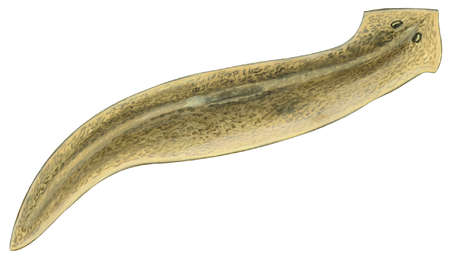
- Body is dorso-ventrally flattened, leaf like (unsegmented) or tape like (segmented).
- They are commonly flat worms.
- They may be free-living like Planarians or parasitic like flukes and tapeworms.
- They are the first animals to show cephalization and have organ system of body organization.
- Body wall:
- Body is triploblastic and bilaterally symmetrical.
- Body wall consists of ectoderm, mesoderm and endoderm. Mesoderm splits and forms the parenchymal cells.
- They are acoelomate animals with no body cavity.
- The epidermis may be absent and if present, it may be cellular or syncytial or ciliated.
- Body systems:
- The muscular system is well developed which is of mesenchymal origin.
- It is composed of circular, longitudinal and oblique muscle fibers situated just beneath the epidermis.
- They have a blind sac body plan with incomplete alimentary canal. Anus is absent and alimentary canal is branched.
- In tapeworm, digestive system is absent.
- Skeletal, respiratory and circulatory system are absent. Gaseous exchange occurs through general body surface.
- Parasitic flatworms possess organs of attachment such as suckers or hooks or both.
- Excretory system has one or two canals with branches, the finer branches end in flame cells or protonephridia or solenocytes.
- Reproduction:
- They are mostly hermaphrodite (monoecious).
- Reproductive system is complex with well-developed gonads.
- In flukes, a pair of testis and a single ovary is present whereas, in tapeworm many testes and a single ovary are present.
- Asexual reproduction is found in fresh water and land Planarians which takes place by fission.
- Fertilization is internal.
- There is cross fertilization in trematodes and self-fertilization in cestodes.
- Life cycle is complicated with one or more larval stages and one or more hosts.
Phylum Platyhelminthes is divided into three classes as follows/:
Class: Turbellaria
- They are free-living and ciliated flatworms.
- Body is covered with epidermis which is provided with mucus cells and rod like bodies called rhabdites.
- Majority of them are aquatic (marine).
- They are non-parasitic (independent) forms and the body is unsegmented leaf like.
- Absence of hooks and suckers.
- Digestive system is developed with alimentary canal consisting of everted pharynx.
- They have regeneration capacity.
- e.g. Planaria (Dugesia), Convulata, Bipalium, Thysanozoon etc.
Class: Trematoda
- They are commonly called flukes.
- Body is leaf like and unsegmented, without cilia.
- They are parasitic (may be ectoparasite or endoparasite).
- In most cases, life cycle is digenetic (completes in 2 hosts).
- One or more suckers and hooks are present that help in attachment.
- Digestive system consists of sectorial mouth, simple pharynx and intestine which is two forked and highly branched.
- e.g. Fasciola hepatica (liverfluke), Schistosoma mansoni, Polystoma etc.
Class: Cestoda
- They are endoparasites without cilia and sense organs.
- They consist of hooks and suckers.
- Body is segmented (pseudo-segmentation), each segment called a proglottid.
- Life cycle is digenetic (requiring two hosts to complete the life cycle).
- Digestive system is absent and predigested nutrients are absorbed from the host’s gut through general body surface.
- e.g. Taenia solium (tapeworm), Echinococcus granulosus, Hymenolepis nana etc.